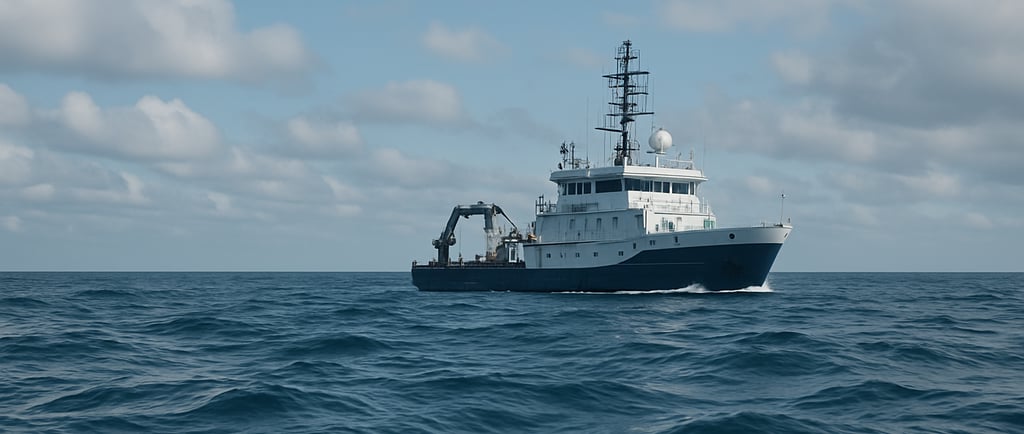Nuclear waste in the Atlantic : a mission to plumb the abyss
EUROPE
Thomas dos Remedios
6/15/20254 min read


NUCLEAR MANAGEMENT BY IMMERSION WITH FAR-REACHING CONSEQUENCES
Between 1950 and 1990, the dumping of radioactive waste at sea was a widespread practice in countries with nuclear weapons and nuclear power plants. For four decades, the nagging question of how to dispose of nuclear waste found a seemingly simple answer: bury it... at the bottom of the ocean. France, the United Kingdom, the Soviet Union, the United States and a dozen other nations dumped their waste in international waters, far from the coast and often at depths exceeding 4,000 meters.
In all, more than 200,000 barrels of radioactive waste now lie on the seabed of the North-East Atlantic, notably in an area some 600 kilometers west of Nantes. At the time, this strategy was considered technically reliable and “responsible”: the areas chosen were supposed to be geologically stable, with little marine life, and the drums were designed to prevent any leakage over a period of 20 to 25 years.
The submerged waste was not the most dangerous - it was neither spent fuel nor highly radioactive materials - but so-called very low- to medium-level waste: contaminated gloves, tools, maintenance residues. This easy, economical choice, with no long-term visibility, is now widely questioned. A total ban on these practices was not introduced until 1993, when an amendment to the London Convention on the Prevention of Marine Pollution came into force.
AN UNPRECEDENTED MARINE EXPEDITION TO ASSESS IMPACT
Today, an interdisciplinary scientific mission led by CNRS, Ifremer and the French Nuclear Safety and Radiation Protection Authority (ASNR) will attempt to understand what remains of these drums, what residual risks they pose, and what effects they may have had on marine ecosystems. The first expedition, scheduled to last one month from June 15, 2025, will mobilize the Ulyx underwater robot, a state-of-the-art device capable of mapping the seabed with the utmost precision and taking deep-sea images. Operated from an oceanographic vessel, the robot will have to locate the barrels, which until now have been very difficult to pinpoint. The first campaigns in the 1980s were only able to confirm their approximate presence, without any precise mapping.
Samples of water, sediment and marine organisms will be taken within a radius of 100 to 150 metres around the sites, to avoid any risk of contamination for the instruments and researchers. These samples will be used to analyze the presence of still-active radionuclides and their possible dispersion in the marine environment. The mission also has a biological and geological dimension. As marine geologist Javier Escartin (ENS-PSL) points out, it will also help us to better understand life in these largely unknown abyssal zones. Biodiversity, chemical interactions between sediments and radioactive elements, and local geology will all be investigated in depth.
CIGÉO: FRANCE FACES THE CHALLENGE OF TERRESTRIAL DISPOSAL
At a time when the effects of past practices are finally being studied, the French government has been preparing the CIGÉO (Centre industriel de stockage géologique) project for over twenty years, a program for the deep disposal of the most hazardous nuclear waste, located between the Meuse and Haute-Marne regions, at Bure. The center will house 83,000 m³ of high- and intermediate-level long-lived waste, some of which will remain hazardous for hundreds of thousands of years, 500 meters underground. The radioactive packages will be stored in a 150-meter-thick layer of clay, designed to provide geological stability over the very long term. To date, only an underground laboratory has been built on the site.
But this exceptionally large-scale project also comes with a staggering price tag. Andra (Agence nationale pour la gestion des déchets radioactifs) has just re-evaluated the bill at between 26.1 and 37.5 billion euros, over the period 2016-2170. The French government, which relies on contributions from waste producers (EDF, Orano, CEA), must set the final cost by ministerial decree by 2026. The timetable has slipped: commissioning, initially scheduled for between 2035 and 2040, has now been postponed to 2050, with an operating phase estimated to last a century, followed by dismantling and total closure of the site around 2170. The gradual excavation of 250 kilometers of tunnels, the construction of reception areas, storage cells and surface infrastructures represent an unprecedented technical and logistical challenge.
A RADIOACTIVE MEMORY THAT ENGAGES FUTURE GENERATIONS
Nuclear waste poses a unique question in terms of governance: how can we guarantee the safety of hazardous materials over periods that far exceed any human memory? What the expedition at sea, like the CIGÉO project, shows is that technical solutions are not enough to extinguish political, environmental and ethical concerns.
The sunken barrels, once thought to be beyond our reach, are now a stark reminder of the limits of science and the choices made in the past. As for the CIGÉO project, it projects current responsibilities over several generations, in an energy world that is itself uncertain. The extension of the lifespan of nuclear reactors, the announced construction of new EPRs, and possible developments in the treatment of spent fuel could modify the volumes of waste to be stored, and the very longevity of the site.
Between these two extremes - the forgotten depths of the sea and the underground galleries yet to be built - a radioactive memory is taking shape. A memory made up of technical choices, economic gambles, but also collective blindness. More than ever, the management of nuclear waste cannot be summed up as a question of engineering: it involves a very long-term responsibility, for which neither the ocean nor the earth can offer oblivion.
Thomas dos Remedios, pour SPECTIO
Les propos exprimés n’engagent que leurs auteurs et ne reflètent pas la position du Think Tank Spectio.
